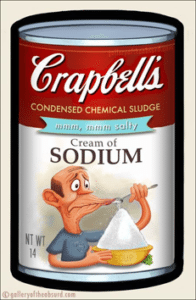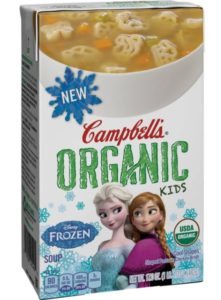MMMmmmm Campbell’s
I grew up eating Campbell’s soup and I loved all the flavours – chicken noodle, tomato, vegetable and mushroom. Back in the 1970’s almost every casserole recipe had a tin of Campbell’s mushroom soup in it. Even with all the knowledge that I now have in nutrition, there are some habits that are hard to break.
But Campbell’s original soup is one that I have broken up with for good. The ingredients label is the cause of my leaving Campbell’s behind, and is likely why so many are doing the same1. Let’s analyze the ingredients one by one, so you understand why you too may want to look for alternatives to the classic soups.
| INGREDIENT | CONCERN |
|---|---|
| 1. Water | Is the water filtered? Was it previously stored in plastic and now contains BPA? |
| 2. Mushrooms | Okay – I will give this one to you Campbell’s- I like this ingredient |
| 3. Modified Corn starch | Corn itself is highly genetically modified – one to avoid! And the word “modified” is perplexing – modified how exactly? Often modified means to include MSG – MSG and its related products have been linked skin rashes, nausea, migraine headaches, heart irregularities, and even seizures2, making MSG another one to avoid. |
| 4. Canola or soybean oil | First of all, which one is it? Canola or Soybean? Either way, they are both genetically modified – an absolute avoid! |
| 5. Wheat flour | Unless organic, wheat is sprayed with a possibly carcinogenic/toxic chemical called glyphosate3– an absolute avoid! |
| 6. Corn starch | See comments under 3. Modified Corn starch – another dose of GMO. |
| 7. Cream | A dairy product. Dairy is full of chemicals used in processing and production. Not only do the medications used on dairy cows (ie hormones and antibiotics) make their way into the milk, the pesticides in foods the animal consumes also do. The processes of pasteurization can also add in more harmful chemicals to the milk. Here are a few other points from Dr. Mark Hyman: “The Federal Trade Commission (FTC) recently asked the UDSA to look into the scientific basis of the claims made in the “milk mustache” ads. Their panel of scientists stated the truth clearly:
Plus, dairy may contribute to even more health problems, like:
Due to these concerns, many have begun to consider raw milk an alternative. But it may not be the ideal answer to all dairy concerns. While it is true that raw, whole, organic milk eliminates concerns like pesticides, hormones, antibiotics, and the effects of homogenization and pasteurization, these benefits don’t outweigh dairy’s potential risks linked with infection and chronic disease. From an evolutionary point of view, milk is a strange food for adult humans. Until 10,000 years ago we didn’t domesticate animals and weren’t able to drink milk (unless some brave hunter-gather milked a wild tiger or buffalo!). If you don’t believe that, consider this: The majority of humans naturally stop producing significant amounts of lactase — the enzyme needed to properly metabolize lactose, the sugar in milk — sometime between the ages of two and five. In fact, for most mammals, the normal condition is to stop producing the enzymes needed to properly digest and metabolize milk after they have been weaned. Our bodies just weren’t made to digest milk on a regular basis. Instead, most scientists agree that it’s better for us to get calcium, potassium, protein, and fats from other food sources, like whole plant foods — vegent-tables, fruits, beans, whole grains, nuts, seeds, and seaweed.”4 |
| 8. Buttermilk powder | See comments in point 7 above. |
| 9. Salt |  Salt is a mineral that is needed in small amounts by our cells (ie 1 g per day). The problem with processed foods is that salt is often used in higher amounts to enhance flavour. In this soup can there is over 730mg– almost enough for your entire daily allowance. Canadians eat about 3400 mg of sodium each day – more than double the amount we need. The problem with salt is that it can increase blood pressure. High blood pressure is a major factor in stroke and heart disease, one of the leading causes of death in Canada. There is also increasing evidence of links between high salt intake and stomach cancer, osteoporosis, obesity, kidney stones, kidney disease, vascular dementia and water retention. Salt can also exacerbate the symptoms of asthma, Ménière’s disease and diabetes5,6 Salt is a mineral that is needed in small amounts by our cells (ie 1 g per day). The problem with processed foods is that salt is often used in higher amounts to enhance flavour. In this soup can there is over 730mg– almost enough for your entire daily allowance. Canadians eat about 3400 mg of sodium each day – more than double the amount we need. The problem with salt is that it can increase blood pressure. High blood pressure is a major factor in stroke and heart disease, one of the leading causes of death in Canada. There is also increasing evidence of links between high salt intake and stomach cancer, osteoporosis, obesity, kidney stones, kidney disease, vascular dementia and water retention. Salt can also exacerbate the symptoms of asthma, Ménière’s disease and diabetes5,6 |
| 10. Yeast extract | Used as a food additive to improve taste, this product can contain glutamates (a product that is concentrated to make MSG) (see note on MSG in 3. Modified Corn Starch above). As such, foods that contain yeast extract cannot be labeled as MSG-free, though they do not have the same high levels of glutamate. However, it does also contain B vitamins that are beneficial so it may be up to you and your family to weigh the benefit of B vitamins vs the potential reaction to glutamates7 |
| 11. Flavour | This is an important one. What does this mean? What type of flavour? Anytime you read this on a label you need to replace it with the word “chemical” because that is what it is. I would argue that it is not something you want to consume. See point 1 below for what the Environmental Working Group has to say about “natural flavour” |
| 12. Potassium chloride (salt substitute) | Didn’t we just add salt as ingredient #9 – is this a way to get around the sodium levels and make them even higher?Potassium chloride has been touted as being a salt substitute without the dangers of high sodium levels raising blood pressure and contributing to risk of heart attack and stroke. However for some people, ingesting more potassium can lead to excessively high potassium levels called hyperkalemia, with dangerous health consequences such as heart arrhythmias and even heart arrest. Risk factors that make a person more susceptible to dangerous hyperkalemia include having kidney failure, type II diabetes, Conn’s disease, bladder or kidney stones and most importantly, being on diuretics or other medications to lower blood pressure (such as ACE inhibitors, angiotensin II receptor blockers). For people with the above conditions it is wise to outright avoid high intake of both potassium or sodium salts- both of which are in this soup!8 |
| 13. Soy protein isolate | Soy is highly genetically modified – an absolute avoid! This is also another contributor to MSG |
| 14. Sauterne wine | Wine?! In a soup given to children… maybe that is why I liked it so much – LOL! Seriously though, grapes are on the list of the 12 most heavily pesticide-sprayed foods (the dirty dozen), so you are getting an extra dose of chemicals in your soup. |
| 15. Sea salt | See comment under point 9. Don’t we have enough salt already? Is it necessary to add more? The food industry manipulates the amounts of either fat, sugar or salt in recipes so we become “addicted” to them. But, sea salt is good for you – right?! In minimal doses and not at the levels used in processed foods it might be. |
| 16. Onion powder 17. spices |
Which spices? Have they been irradiated? Most spices, along with many fruits, vegent-tables and meats, are irradiated to effectively inactivate bacteria that are resistant to antibiotics and to eliminate other contaminants. It’s a growing technology used to increase food safety and reduce food poisoning. However, questions regarding the consequences of irradiation have been raised, stating it could cause chromosomal damage to persons consuming it as well as reducing the nutritional value of foods.In 1997, the WHO along with the FAO (Food and Agriculture organization of the UN) concluded that food irradiated to any dose appropriate to achieve the intended food safety objective is both safe to consume and nutritionally adequate9. However the WHO does concede that many vitamins and nutrients are diminished in the process. The Oxford Journal of Clinic Infectious Disease points out that “because we are not yet able to identify which components of fruits and vegent-tables are beneficial in protection against some cancers, heart disease, and stroke, neither are we able to measure the effect irradiation has on these components. Irradiated foods, when further processed by cooking or freezing, may have more vitamin loss than do non-irradiated processed foods. Determining these effects is important and would have implications regarding full disclosure of nutrient content on labels. Furthermore, because of the concern that nutritional deficits increase susceptibility to or progression of some infections, the possibility still remains that irradiating food may predispose some people to certain infections.10 The conclusion by global food safety boards is that reducing food borne illness worldwide is a high priority that calls for continued irradiation, which unfortunately may then render our food nutritionally deficient. However there are many ways to ensure high food safety standards within your own home through proper storage, washing and preparation that will not reduce the nutritional value of your food. |
1 An interesting and frightening note on “flavour” from the Environmental Working Group:
“The truth is that when you see the word “flavor” on a food label, you have almost no clue what chemicals may have been added to the food under the umbrella of this vague term. For people who have uncommon food allergies or are on restricted diets, this can be a serious concern.
In addition to the flavor-adding chemicals themselves, flavor mixtures often contain natural or artificial emulsifiers, solvents and preservatives that are called “incidental additives,” which means the manufacturer does not have to disclose their presence on food labels. Flavoring mixtures added to food are complex and can contain more than 100 distinct substances. The non-flavor chemicals that have other functional properties often make up 80 to 90 percent of the mixture.
Consumers may be surprised to learn that so-called “natural flavors” can actually contain synthetic chemicals such as the solvent propylene glycol or the preservative BHA. Flavor extracts and ingredients derived from genetically engineered crops may also be labeled “natural,” because the FDA has not fully defined what that term means. (Certified organic “natural flavors” must meet more stringent guidelines and cannot include synthetic or genetically engineered ingredients.)
The companies that make flavoring mixtures are often the same ones that make the fragrance chemicals in perfumes and cosmetics. EWG advocates full disclosure of fragrance ingredients and believes flavoring mixtures should be treated the same way.
EWG considers it troubling that food companies do not fully disclose their ingredients and use vague terms like “flavors.” Consumers have a right to know what’s in their food. We are also concerned that processed food makers manipulate flavors to whet people’s appetite for unhealthy foods and encourage overeating.11
 Campbell’s itself has recognized the need for an overhaul of its ingredients and this year has introduced a line of organic soups. These are made with whole organic vegent-tables and sold in tetra-pack containers with no BPA. Campbell’s CEO Denise Morrison applauded consumers, “They want to know what ingredients are used in their food and where they come from”1
Campbell’s itself has recognized the need for an overhaul of its ingredients and this year has introduced a line of organic soups. These are made with whole organic vegent-tables and sold in tetra-pack containers with no BPA. Campbell’s CEO Denise Morrison applauded consumers, “They want to know what ingredients are used in their food and where they come from”1
But that’s certainly not the only alternative. The healthiest way to have soup is to make it yourself. That way you avoid cans that may be lined with BPA and you know exactly what is going in and how much, starting with organic vegent-tables, nutrient rich bone broth and filtered water. Whether eating homemade or other selections of prepared foods, look for some of the following replacements of the other ingredients in Campbell’s traditional soup:
| INGREDIENT | IMPROVEMENT |
|---|---|
| 1. Water | Ensure the water is from a filtered source. Incorporate bone broth that has been adequately boiled. See Dr. Mercola’s article for the benefits of bone broth: http://articles.mercola.com/sites/articles/archive/2013/12/16/bone-broth-benefits.aspx |
| 2. Mushrooms | |
| 3. Modified Corn starch | Avoid this ingredient altogether |
| 4. Canola or soybean oil | Organic extra-virgin olive oil |
| 5. Wheat flour 6. Corn starch |
Because these are used as thickeners, you can use organic unbleached wheat flour to replace both. Arrowroot and tapioca are gluten-free alternatives, but best to ensure they are organic. |
| 7. Cream | To avoid the accumulation of hormones and antibiotics in milk, you can use organic cream. However, a completely dairy-free option is to try organic coconut milk in the soup, in a smaller amount. The flavor profile of the soup will shift, but is equally rich and hearty. Ensure your coconut milk source is free from guar gum and BPA. One ‘safe’ brand of coco milk is Native Forest. You can also make your own coconut milk from organic coconut flakes using a blender andcheesecloth12 https://www.youtube.com/watch?v=fpxPoizVT9c&hd=1 |
| 8. Buttermilk powder | Flavour and consistency replacement of buttermilk powder can be obtained by the alternatives to corn starch and cream, above, so that buttermilk itself can be eliminated |
| 9. Salt | Use in smaller amount – only use sea salt |
| 10. Yeast extract | Flavour enhancement can be achieved with sea salt. Nutritional yeast is another form of deactivated yeast that will also add flavour and B vitamins and has significantly less glutamate than MSG flavour-enhancers |
| 11. Flavour | Eliminate as ‘natural flavours’ contain synthetic chemicals |
| 12. Potassium chloride (salt substitute) | Eliminate as already included as ingredient 9 |
| 13. Soy protein isolate | This is added for protein and consistency. Leave this out and add cooked organic beans or lentils to the soup to get natural whole-food protein |
| 14. Sauterne wine | Use an organic white wine, low in sugars and preferably sulfite-free. |
| 15. Sea salt | Eliminate as already included as ingredient 9 |
| 16. Onion powder 17. spices |
Organic dried sources of spices are not irradiated. The best way to know how clean your herbs are is to grow your own and add fresh.Look for an ingredients list that lists actual spices used so you know it can’t contain hidden ‘flavours’ or additives. |
There are ways to make healthy choices whether cooking more at home or simply knowing what to avoid when choosing pre-made foods. Learn about the ingredient lists in your shopping cart to make a healthy diet easier for you and your family.
References:
2. http://saveourbones.com/12-dangerous-ingredients/
4. http://drhyman.com/blog/2010/06/24/dairy-6-reasons-you-should-avoid-it-at-all-costs-2/#close
5. http://www.hc-sc.gc.ca/fn-an/nutrition/sodium/index-eng.php
6. http://www.actiononsalt.org.uk/salthealth/
7. http://www.healthline.com/health/food-nutrition/is-yeast-extract-bad-for-me
8. http://www.ncbi.nlm.nih.gov/pmc/articles/PMC1124926/
9. http://www.nfid.org/links/irradiation-foodborne-disease/steele.html
10. http://cid.oxfordjournals.org/content/33/3/375.full
11. http://www.ewg.org/research/ewg-s-dirty-dozen-guide-food-additives/fda-failed-us#flavors



